Monday, September 04, 2006
Monday, August 28, 2006
A brief intro
As a ‘utility’ cyclist who has spent the last 4 years living in Kyoto in Japan where cycling is an intrinsic and universally accessible part of the transport infrastructure I have written up some observations and some suggestions which I hope will contribute to broaden the discussion towards promoting 'utility’ cycling in New Zealand and especially in Christchurch ( where I am presently living ).
I realise that my views are likely to be controversial ( even heretical ) but with cycling languishing at 2% of urban traffic there is a real need for alternative approaches to be explored.
Please keep in mind when reading this that I am describing the existing reality in Kyoto where cycling is the preferred mode of transport for a large proportion of the population.
You can post your comments or links at the end of each topic (and to forward the URL for this site to anyone who you think may be interested ) .
In the lead up to the New Zealand Local Government elections on the 13th of October 2007 I sent out a questionnaire to all the candidates which led to my putting together another web-site ( http://urbanbicycles.googlepages.com/home ) to provide a resource for utility cycling in New Zealand.
Much of what you'll see on this blog has been copied into the Urban Bicycles site.
Ciao for now.
Alan in Addington, Christchurch, New Zealand. (December, 2007).
e-mail: urbanbicycles@gmail.com ( checked daily)
I realise that my views are likely to be controversial ( even heretical ) but with cycling languishing at 2% of urban traffic there is a real need for alternative approaches to be explored.
Please keep in mind when reading this that I am describing the existing reality in Kyoto where cycling is the preferred mode of transport for a large proportion of the population.
You can post your comments or links at the end of each topic (and to forward the URL for this site to anyone who you think may be interested ) .
In the lead up to the New Zealand Local Government elections on the 13th of October 2007 I sent out a questionnaire to all the candidates which led to my putting together another web-site ( http://urbanbicycles.googlepages.com/home ) to provide a resource for utility cycling in New Zealand.
Much of what you'll see on this blog has been copied into the Urban Bicycles site.
Ciao for now.
Alan in Addington, Christchurch, New Zealand. (December, 2007).
e-mail: urbanbicycles@gmail.com ( checked daily)
The situation with cycling in Kyoto:
Kyoto is a city of similar size and contour to Christchurch but with a population of about 1.4 million ( 350,000 in Christchurch) and except for its very hot summer has a similar climate.
Go to the bottom of this posting to open the links to some videos of cyclists in Kyoto.
While the situation for cyclists in Kyoto is not perfect , I feel that in many respects it is a lot more cycle-friendly, less restrictive and safer than it is here in Christchurch and in other cities in New Zealand. (see Kyoto in Kyoto which I put together in Feb/2004),
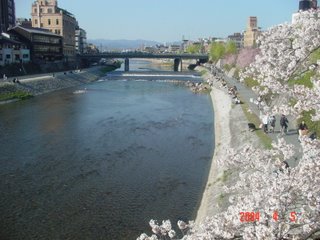
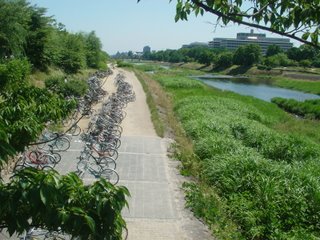
Cyclists in Kyoto enjoy a high degree of freedom with where they can ride and because they are thought of more as 'fast moving pedestrians' rather than as 'vehicles', they share footpaths (where-ever they exist) with pedestrians,
- even in what would be considered in New Zealand to be areas of high pedestrian traffic (shopping malls etc).
Whether cyclists ride on the roads or on the pavements is optional but where there are pavements over 95% of cyclists use them. Cyclists are free to travel against the traffic in narrow one way streets.
Helmets are not required and have only recently started to appear in bicycle retail shops and are hardly ever worn by commuters.
The pace that cyclists move at is generally very relaxed.
Apart from the Police checking to see if bicycles are stolen and Local Government confiscating 'illegally' parked bicycles , there is no interference or involvement in cycling by the state and nor are there any special provisions made for cyclists. i.e. no cycle (only)ways,no cycle-lanes, very few markings to delineate 'shared' pavements etc. Laissez faire cycling basically.....
It is this unfettered degree of freedom which I believe makes cycling the preferred choice of transport for so many in Kyoto.

A large proportion of the population from all sections of society, including a lot of elderly people, mothers with their young children and all the grocery shopping , fashionable young ladies toting umbrellas and cell-phones, businessmen in suits and even the police use bicycles in their everyday lives.

Mountain bikes and ‘road’ bikes are relatively uncommon and the bicycles most commonly used have either no gears or have 3, 5, or 7 speed internal hub gearing systems with internal hub electrical dynamo in the front wheel for lighting.
There are no 'men's bikes in Japan and NOBODY wears lycra.
There are a similar number of people to those in New Zealand who are into high-speed recreational riding and commuter cycling but I'd guess they're only about 5% (?)of the actual number of cyclists in Japan.
It is this 95% (?) that is missing ( and not being catered for ) in New Zealand that is the area Local Governments in New Zealand should be focusing their attentions on if they are actually serious about achieving the benefits that maximising cycling brings.
Fold-up bicycles which can be taken onto trains, subways, buses or carried in cars and electric power-assisted bicycles are also starting to become well-established among commuters in Kyoto.
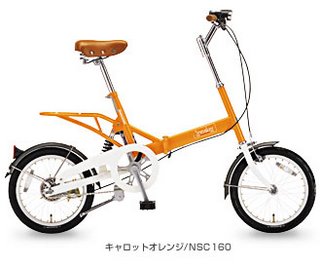
In the 10 years I spent cycling in Japan on both mountain bikes and other commuter bikes , both long distance and in cities , I never saw any accidents,-doesn't mean they don't happen, but it generally felt a lot safer than it does in New Zealand.
------------------------------------------------------------------
To see some
SHORT VIDEOS OF CYCLISTS IN KYOTO,
Starting from a 'no bicycle parking here' sign, I took this on my mobile phone while riding down along the southern end of Kyoto's Terra Machi Street showing how bicycles are a truly integral part of Kyoto's transport infrastructure.
Notice how much bicycle parking space 1 car takes up.
Here's another short video which I took while riding southward along Kyoto's Kamogawa river under the Shijo bridge passing 'homeless' people's homes, parked bicycles, other (unhelmeted) cyclists and unconcerned pedestrians.
-------------------------------------------------------------------
This VIDEO taken along Oike Dori which passes Kyoto's City Hall.
-and a VIDEO taken the narrow back streets in Osaka:
( thanks to Edward P from Christchurch for these two videos)
--------------------------------------------------------------------
Another short video of upper Terra Machi dori
--------------------------------------------------------------------------------------------------------
Some interesting comments from other cyclists who've enjoyed cycling in Kyoto.
A rave on cycling in Kyoto as compared to New York.
Cycling Culture in Japan ( another blog )
Paul Dorn from San Francisco California made some useful observations on a trip to Osaka (adjacent to Kyoto). (Paul has also written some other pertinent ideas on commuter cycling on other pages which are linked to that site).
A 'thread' from JapanToday on the threat cyclists pose:
"People here use their bikes for daily transportation!"
"I don't think I saw a single cyclist wearing a helmet"
"Riders almost always used sidewalks where these were available"
Cycling in the Netherlands.
Waxing cyclical from the Netherlands
Cycling in Denmark
Go to the bottom of this posting to open the links to some videos of cyclists in Kyoto.
While the situation for cyclists in Kyoto is not perfect , I feel that in many respects it is a lot more cycle-friendly, less restrictive and safer than it is here in Christchurch and in other cities in New Zealand. (see Kyoto in Kyoto which I put together in Feb/2004),

This picture was taken in the centre
of Kyoto city looking north along Kamogawa river along which a pathway shared by pedestrians and cyclists runs.
of Kyoto city looking north along Kamogawa river along which a pathway shared by pedestrians and cyclists runs.

Bicycles parked along Kamogawa River near
the Demachi Yanagi Subway station
in the north of Kyoto City.
the Demachi Yanagi Subway station
in the north of Kyoto City.
Cyclists in Kyoto enjoy a high degree of freedom with where they can ride and because they are thought of more as 'fast moving pedestrians' rather than as 'vehicles', they share footpaths (where-ever they exist) with pedestrians,
- even in what would be considered in New Zealand to be areas of high pedestrian traffic (shopping malls etc).
Whether cyclists ride on the roads or on the pavements is optional but where there are pavements over 95% of cyclists use them. Cyclists are free to travel against the traffic in narrow one way streets.
Helmets are not required and have only recently started to appear in bicycle retail shops and are hardly ever worn by commuters.
The pace that cyclists move at is generally very relaxed.
Apart from the Police checking to see if bicycles are stolen and Local Government confiscating 'illegally' parked bicycles , there is no interference or involvement in cycling by the state and nor are there any special provisions made for cyclists. i.e. no cycle (only)ways,no cycle-lanes, very few markings to delineate 'shared' pavements etc. Laissez faire cycling basically.....
It is this unfettered degree of freedom which I believe makes cycling the preferred choice of transport for so many in Kyoto.

A large proportion of the population from all sections of society, including a lot of elderly people, mothers with their young children and all the grocery shopping , fashionable young ladies toting umbrellas and cell-phones, businessmen in suits and even the police use bicycles in their everyday lives.

Mountain bikes and ‘road’ bikes are relatively uncommon and the bicycles most commonly used have either no gears or have 3, 5, or 7 speed internal hub gearing systems with internal hub electrical dynamo in the front wheel for lighting.
There are no 'men's bikes in Japan and NOBODY wears lycra.
There are a similar number of people to those in New Zealand who are into high-speed recreational riding and commuter cycling but I'd guess they're only about 5% (?)of the actual number of cyclists in Japan.
It is this 95% (?) that is missing ( and not being catered for ) in New Zealand that is the area Local Governments in New Zealand should be focusing their attentions on if they are actually serious about achieving the benefits that maximising cycling brings.
Fold-up bicycles which can be taken onto trains, subways, buses or carried in cars and electric power-assisted bicycles are also starting to become well-established among commuters in Kyoto.

In the 10 years I spent cycling in Japan on both mountain bikes and other commuter bikes , both long distance and in cities , I never saw any accidents,-doesn't mean they don't happen, but it generally felt a lot safer than it does in New Zealand.
------------------------------------------------------------------
To see some
SHORT VIDEOS OF CYCLISTS IN KYOTO,
Starting from a 'no bicycle parking here' sign, I took this on my mobile phone while riding down along the southern end of Kyoto's Terra Machi Street showing how bicycles are a truly integral part of Kyoto's transport infrastructure.
Notice how much bicycle parking space 1 car takes up.
Here's another short video which I took while riding southward along Kyoto's Kamogawa river under the Shijo bridge passing 'homeless' people's homes, parked bicycles, other (unhelmeted) cyclists and unconcerned pedestrians.
-------------------------------------------------------------------
This VIDEO taken along Oike Dori which passes Kyoto's City Hall.
-and a VIDEO taken the narrow back streets in Osaka:
( thanks to Edward P from Christchurch for these two videos)
--------------------------------------------------------------------
Another short video of upper Terra Machi dori
--------------------------------------------------------------------------------------------------------
Some interesting comments from other cyclists who've enjoyed cycling in Kyoto.
A rave on cycling in Kyoto as compared to New York.
Cycling Culture in Japan ( another blog )
Paul Dorn from San Francisco California made some useful observations on a trip to Osaka (adjacent to Kyoto). (Paul has also written some other pertinent ideas on commuter cycling on other pages which are linked to that site).
A 'thread' from JapanToday on the threat cyclists pose:
"People here use their bikes for daily transportation!"
"I don't think I saw a single cyclist wearing a helmet"
"Riders almost always used sidewalks where these were available"
Cycling in the Netherlands.
Waxing cyclical from the Netherlands
Cycling in Denmark
Labels: Cycling in Kyoto Japan
Slow cycling
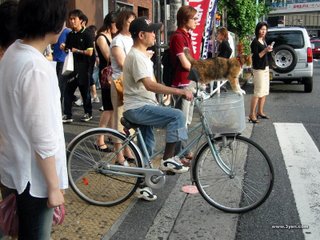
A cat sharing its space with its cyclist and other road users.
( You can click on these pictures to enlarge them ).
The major point of difference between the cycling cultures in Japan and New Zealand is that the pace at which cyclists habitually move in Japan is considerably slower than that at which cyclists expect they should travel in New Zealand.
The attitudinal and behavioural differences between the (active) cycling cultures may be the reasons why different cycling technologies and practices prevail in each country.
The lack of uptake of utility cycling in New Zealand may be due to some extent to a reluctance among active cyclists here to recognise the needs of (would be) slower cyclists.
While most cycle-activism in New Zealand is being done by and on behalf of the interests of athletic high-speed cyclists for whom cycling is also a recreational activity, the interests of our ‘would-be’ cyclists (like those who make up the majority of urban cyclists in Japan who just want to get around at a relaxed pace) are being completely neglected.
Nobody is working for the interests of the 'would be' cyclists.
It is from this section of society that the greatest increases in those taking up 'utility' cycling could be expected to come. e.g. the elderly and everyone who lives in the inner suburbs.
Utility cycling is not a race: As long as cycle action groups, local governments, bicycle retailers and roading authorities refuse to take into consideration the needs of ‘slow’ cyclists, ‘utility’ cycling will remain what it is today: 2% of all urban traffic.

Local government’s role in promoting cycling.
I have no doubt that if Local Governments in Japan were to introduce laws that compelled cyclists to behave as they do in New Zealand ( wearing helmets, riding with cars on roads and that they all had to ride mountain and road bikes) that cycling would die a swift death as it has done here.
To help cycling become established as an integral, rather than to remain as an incidental part of New Zealand's transport infrastructure, the Christchurch City Council has a natural responsibility as the Local Territorial Authority governing what has historically been New Zealand's most cycle-friendly city to take a leading role in setting precedents which can be followed by other L.T.A.s.
Setting aside funding to host promotional and educational campaigns and passing cycle-friendly by-laws to establish an environment conducive to ‘slow’ utility cycling will help the CCC realise its stated goals of increasing numbers of people taking up utility cycling while also contributing to their safety and enjoyment.
When doing cost benefit analysis, Local Government Engineers generally recognise that for every dollar spent on promoting the switch from driving to cycling, a benefit of $20 can be realised through reductions in costs such as wear and tear on roads etc, - so there is a strong economic incentive for Local Governments to get more actively involved in facilitating and actively promoting utility cycling.
New Zealand's Local Governments are required under the Resource Management Act
to be working towards achieving the goals set out in the Kyoto Protocol on reducing Greenhouse gas emissions (which in New Zealand mainly means reducing unnecessary use of carbon burning vehicles) and regardless of that, it makes plain economic sense to reduce the NZ$10 million* of imported fossil fuels that our transport sector burns through every day.
http://www.med.govt.nz/templates/MultipageDocumentTOC____20515.aspx
http://www.eeca.govt.nz/transport/indexnew.html
http://www.greens.org.nz/searchdocs/speech9698.html
Maximising opportunities for urban commuters to take up cycling is an effective means of achieving these goals.
Despite all the good work that has been and is being done by the Christchurch City Council to facilitate cycling, there is still a lot of work that could be done to encourage people out of their carbon burners and onto their bikes.
New Zealanders under the age of 60 have no experience of seeing large numbers of cyclists in their cities and in general seem to feel inconvenienced or even threatened by their presence on the roads.
Changing the way that cycling is viewed by many as something that only kids or gung-ho twenty-something fitness freaks do on weekends by actively encouraging people to experience and enjoy for themselves the feeling of freedom and physical well-being that comes from being on a bicycle while also maintaining their awareness of other positives such as reductions in greenhouse gas emissions, traffic, noise and need for parking space are things the CCC could take a leading role in.
A working party could be formed from which members could be assigned specific fact-finding tasks using the internet (no need for junkets) to communicate with those who have been involved in cycle-related policies in cities such as Kyoto , Amsterdam and Copenhagen to find out about the attitudes, practices and technologies that make cycling so popular,
Funding for the promotion and implementation of utility cycling projects could be derived from levies on cars coming into the city.
To help cycling become established as an integral, rather than to remain as an incidental part of New Zealand's transport infrastructure, the Christchurch City Council has a natural responsibility as the Local Territorial Authority governing what has historically been New Zealand's most cycle-friendly city to take a leading role in setting precedents which can be followed by other L.T.A.s.
Setting aside funding to host promotional and educational campaigns and passing cycle-friendly by-laws to establish an environment conducive to ‘slow’ utility cycling will help the CCC realise its stated goals of increasing numbers of people taking up utility cycling while also contributing to their safety and enjoyment.
When doing cost benefit analysis, Local Government Engineers generally recognise that for every dollar spent on promoting the switch from driving to cycling, a benefit of $20 can be realised through reductions in costs such as wear and tear on roads etc, - so there is a strong economic incentive for Local Governments to get more actively involved in facilitating and actively promoting utility cycling.
New Zealand's Local Governments are required under the Resource Management Act
to be working towards achieving the goals set out in the Kyoto Protocol on reducing Greenhouse gas emissions (which in New Zealand mainly means reducing unnecessary use of carbon burning vehicles) and regardless of that, it makes plain economic sense to reduce the NZ$10 million* of imported fossil fuels that our transport sector burns through every day.
http://www.med.govt.nz/templates/MultipageDocumentTOC____20515.aspx
http://www.eeca.govt.nz/transport/indexnew.html
http://www.greens.org.nz/searchdocs/speech9698.html
Maximising opportunities for urban commuters to take up cycling is an effective means of achieving these goals.
Despite all the good work that has been and is being done by the Christchurch City Council to facilitate cycling, there is still a lot of work that could be done to encourage people out of their carbon burners and onto their bikes.
New Zealanders under the age of 60 have no experience of seeing large numbers of cyclists in their cities and in general seem to feel inconvenienced or even threatened by their presence on the roads.
Changing the way that cycling is viewed by many as something that only kids or gung-ho twenty-something fitness freaks do on weekends by actively encouraging people to experience and enjoy for themselves the feeling of freedom and physical well-being that comes from being on a bicycle while also maintaining their awareness of other positives such as reductions in greenhouse gas emissions, traffic, noise and need for parking space are things the CCC could take a leading role in.
A working party could be formed from which members could be assigned specific fact-finding tasks using the internet (no need for junkets) to communicate with those who have been involved in cycle-related policies in cities such as Kyoto , Amsterdam and Copenhagen to find out about the attitudes, practices and technologies that make cycling so popular,
Funding for the promotion and implementation of utility cycling projects could be derived from levies on cars coming into the city.
Labels: cycling, local government
Freedom of movement
It is in the interests of cyclists that they take care of themselves.
‘Ride where-ever you can. Just don't do anything stupid.’ seems to be the ethos among cyclists in Japan.
Cyclists in Japan can plan their route according to what surfaces are physically available to ride on, as it unfolds before them.
Apart from not being permitted to ride on Expressways or to do right hand turns with vehicles at intersections, they are unimpeded in their choice of route.
Denying cyclists the choice of making use of footpaths, pedestrian crossings, free left hand turns and contra-flow rights in one-way streets all detract from the experience of cycling that cyclists should naturally enjoy.
‘Ride where-ever you can. Just don't do anything stupid.’ seems to be the ethos among cyclists in Japan.
Cyclists in Japan can plan their route according to what surfaces are physically available to ride on, as it unfolds before them.
Apart from not being permitted to ride on Expressways or to do right hand turns with vehicles at intersections, they are unimpeded in their choice of route.
Denying cyclists the choice of making use of footpaths, pedestrian crossings, free left hand turns and contra-flow rights in one-way streets all detract from the experience of cycling that cyclists should naturally enjoy.
Labels: cycling, freedom of movement
Footpaths

Where footpaths are available in Japan, cyclists ride safely with ease among pedestrians.
In New Zealand, cyclists have literally been legislated to death (11 killed and God knows how many injured so far in the 2006 year period) by being forced into the 'combat zone' where most cycling fatalities occur
- while our valuable footpaths are sanctioned off and left as an under-utilised resource.
The law which prohibits the use of footpaths by cyclists (except by delivery workers) may have been appropriate in the era in which it was passed when people used to walk to get around and when traffic was much lighter and slower- moving than it is in today's world.
This by-law is obsolete and needs to be reviewed and rescinded.
The footpaths in Japan are no different from the footpaths in New Zealand.
There are just as many driveways with cars coming out of them and a lot more pedestrians and certainly a lot more cyclists using them.
The maneuverability of cycles makes the chance of collision with pedestrians extremely low (whatever the asserted perception by pedestrians is on this matter) while the reality is that cyclists vs. car collisions have much graver consequences for all involved.
Cyclists have the benefit of being able to hear everything that drivers can't hear from inside a car, - such as the sound of cars approaching intersections and pulling out of drive-ways.
The use of bicycle bells should be encouraged .
The Christchurch City Council has the power to change by-laws to relax the restriction against cyclists using footpaths although it seems they have been told by their legal advisers that amending existing by-law which prohibits use of footpaths by cyclists would open them up to law-suits.
All care, no responsibility:
-So where does Local Government start taking real positive action to promote utility cycling?
The CCC could take the lead in changing prevailing attitudes which are currently against allowing cyclists to invade the sanctity of our precious pavements by running education campaigns which focus on promoting the benefits of having cyclists use them and to help assuage the fears of the pedestrian public.
Bicycles can be relatively fast moving but because they are highly maneuverable they can move quite safely among pedestrians, even in densely populated areas such as shopping malls and on city pavements.
Compelling cyclists to dismount and walk their bikes when passing through some areas (such as shopping malls) may seem from the perspective of non-cyclists to be reducing the risk of collision but from the cyclist’s perspective it is (usually) a nonsensical imposition which does nothing towards eliminating what they see as an imagined threat.
See this article on the pros and cons of allowing cyclists to use footpaths....
- http://viastrada.co.nz/story/velocity_munich
- Cycle paths are much preferred by cyclists over cycle lanes, even if their actual safety is not as good as the on-road solution. If NZ wanted to be able to start using pathways alongside roads as a promotional measure, central government needs to review the existing give way rules. In Europe, cyclists on a pathway have right of way over turning traffic, whereas in NZ, all other traffic has right of way over a cycle path, even motorists turning from a side street into a main road. Without such a give way rule revision, cycle paths would never offer a level of service acceptable to the majority of the existing cycling population. ( June 2007 )
Labels: Cycling paths
The perception and assertion that cycling is dangerous:

Yes, accidents do happen ,-but cycling itself is rarely 'dangerous'.
-But 10 Cyclists have died and numerous others have been injured on New Zealand roads so far this year ( September 2006) many in accidents involving motor vehicles. ( http://www.landtransport.govt.nz/research/toll.html )
HOW MANY IS 'TOO MANY?'
Having to share the road with motor vehicles makes cycling potentially more dangerous than it needs to be.
Being aware of the potential for serious consequences resulting from interaction with motor vehicles is enough to dissuade most people from making the change to cycling.
Allowing cyclists to ride separately from motor vehicles will reduce opportunities for accidents to happen and will provide an environment in which people feel confident that cycling is a safe option.
Cyclists should be re-categorised as 'fast moving pedestrians' rather than they are currently as 'vehicles' (under Road User Rules) and should not be obliged to share the road with motor vehicles where alternatives exist.
To see a breakdown of the figures for accidents involving cyclists in 2005, open this .pdf file from Land Transport New Zealand.
http://www.transport.govt.nz/assets/NewPDFs/NewFolder/cyclists-2005.pdf
To see something on the causes of accidents http://www.bicyclinginfo.org/bc/types.htm (from U.S.A)
Cycle Lanes
First rule of cycling in New Zealand: NEVER TRUST DRIVERS !!!
Governments can set regulations on the movements of cars and bikes but they can never actually physically control their transgressions into each other's spaces,-which is inevitably where cyclists come off worst.
( 8 cyclists have died in New Zealand so far [September] ( now 11 dead in October) this year, keep counting! )
http://www.landtransport.govt.nz/research/toll.html
Cycle Lanes are useful for those cyclists who want to ride as fast as they can go but put cyclists right in the danger zone.
Car doors and cars pulling into and out of parallel parking spaces along the roads and cars crossing cycle lanes to turn left are a major danger to cyclists using allocated lanes.
Cycle Lanes are not an appropriate place for (what could be) the greatest number of (would be) cyclists who are more likely to want to move at a more relaxed pace and with some degree of physical separation from the 'river of steel'.
To reduce the confusion felt by cyclists finding that their allocated cycling lane has petered out into nothing, it is important that they be allowed to make free and unfettered use of footpaths where-ever they exist.
Enabling cyclists to use pavements will provide the degree of separation that will help intending cyclists to make the change
and will help to lower the incidence of collisions with significantly bigger and faster vehicles.
We aren't allowed to walk on the roads. Why are we forced to cycle on them ?
See http://www.bianz.org.nz/96.html
for new rules on cycling in NZ
Governments can set regulations on the movements of cars and bikes but they can never actually physically control their transgressions into each other's spaces,-which is inevitably where cyclists come off worst.
( 8 cyclists have died in New Zealand so far [September] ( now 11 dead in October) this year, keep counting! )
http://www.landtransport.govt.nz/research/toll.html
Cycle Lanes are useful for those cyclists who want to ride as fast as they can go but put cyclists right in the danger zone.
Car doors and cars pulling into and out of parallel parking spaces along the roads and cars crossing cycle lanes to turn left are a major danger to cyclists using allocated lanes.
Cycle Lanes are not an appropriate place for (what could be) the greatest number of (would be) cyclists who are more likely to want to move at a more relaxed pace and with some degree of physical separation from the 'river of steel'.
To reduce the confusion felt by cyclists finding that their allocated cycling lane has petered out into nothing, it is important that they be allowed to make free and unfettered use of footpaths where-ever they exist.
Enabling cyclists to use pavements will provide the degree of separation that will help intending cyclists to make the change
and will help to lower the incidence of collisions with significantly bigger and faster vehicles.
We aren't allowed to walk on the roads. Why are we forced to cycle on them ?
See http://www.bianz.org.nz/96.html
for new rules on cycling in NZ
Labels: Cycle Lanes
Curbs and Paving

Curbs:
All future roading projects should use cycle-friendly curbing with gently curved surfaces which can be mounted by cyclists when evading cars.
Paving:
All future paving projects should take the needs of cyclists into consideration.
Avoid using highly polished paving surfaces which get very slippery when wet and don’t use
chequered patterns if laying brick paving as the visual effect is quite disconcerting to cyclists riding over them.
Stairways should be modified to include a ramp for cyclists to either ride or walk their bikes on.
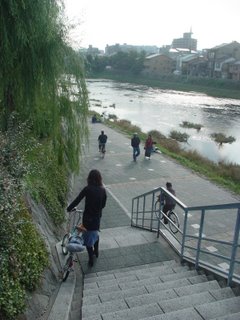

Helmet Law
Helmets are neither required nor worn by cyclists in Japan and have only recently started to become available through cycling retailers.
Helmet law:
To some not insignificant extent the mandatory wearing of helmets has acted to dissuade a large number of would be cyclists from riding their bikes.
Local Government could make recommendations to Central Government to rescind or relax this law and to make the wearing of helmets discretionary on the user.
http://www.magma.ca/~ocbc/fatalsnz.html
http://www.cosc.canterbury.ac.nz/nigel.perry/cycling2001CurseOrCure150.pdf
http://www.landtransport.govt.nz/study-guides/cycles.html
Helmet law:
To some not insignificant extent the mandatory wearing of helmets has acted to dissuade a large number of would be cyclists from riding their bikes.
Local Government could make recommendations to Central Government to rescind or relax this law and to make the wearing of helmets discretionary on the user.
http://www.magma.ca/~ocbc/fatalsnz.html
http://www.cosc.canterbury.ac.nz/nigel.perry/cycling2001CurseOrCure150.pdf
http://www.landtransport.govt.nz/study-guides/cycles.html
Parking facilities


This type of lock which snaps around the rear wheel is commonly used.

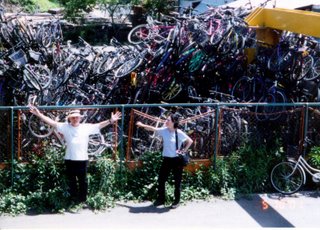

To reduce the space taken by parked bicycles , funding could be set aside by Councils in New Zealand to install vertical wall hangers such as can be seen @: http://www.bikeup.com/vertical/
These hangers are much more space efficient than more traditional horizontal parking models and the Council could set an example by having them installed around their own buildings.
http://www.rutlandindustries.com/mini_mum/index.html
Web-based time/distance/difficulty calculator:
People who have always got around by car are often surprised when they find out how little time it actually takes to get around a city by bicycle. Not knowing just how easy and pleasant cycling is and how little time it would actually take to get to where they’re going is probably one of the things that stops many ‘would be’ cyclists from making the change.
Funding could be put aside to commission a study to get comprehensive information on the times, distances and levels of difficulty for specific routes from which maps can be made so a web-based calculation program can be written for people intending to cycle any given route.
Being able to calculate this information will enable commuters to make the decision to make the change from driving to cycling. The technology is available: Use it.
Funding could be put aside to commission a study to get comprehensive information on the times, distances and levels of difficulty for specific routes from which maps can be made so a web-based calculation program can be written for people intending to cycle any given route.
Being able to calculate this information will enable commuters to make the decision to make the change from driving to cycling. The technology is available: Use it.
Appropriate bicycles for ‘slow’ utility cycling:
Imagine living in a world in which when you needed to buy a car for your everyday needs: shopping, getting around in all weathers etc and being presented with a choice of Formula 1 racing cars and racing saloons.
- So it is with cycling in New Zealand,-with bicycles designed for off-road recreational riding being presented as the only option for use on flat city roads while the market is deprived of the alternatives which will inevitably prove to be more appropriate for urban environments .
There is a disappointingly restrictive lack of variety in the choice of appropriate cycling technologies being offered by all but a small handful of brave cycle retailers in New Zealand.
i.e. mountain bikes prevail in Christchurch city which is (for the most part) dead flat.
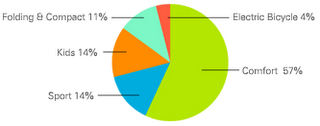
This graph is from Japan's biggest bicycle manufacturer 'Bridgestone' which has 11% of the market in Japan.
I'd guess that a similar graph for bicycle sales in New Zealand would look more like:
sports cycles 80% , kids, 19.99 %,
'comfort cycles' 0% , folding & compact and electric bicycles 0.01 %
Some examples of bikes that may prove to be more appropriate for use by urban 'utility' cyclists.
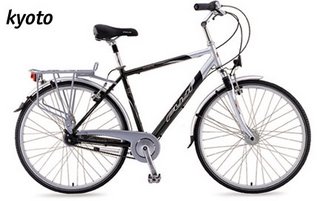
'Kyoto' by Fuji Bikes.
( ironically now manufactured in the U.S.A. and not available in Kyoto ,-although similar bikes are.
I personally used a similar bike in Kyoto for 4 years with 7-speed internal hub gearing , grip shift , internal hub dynamo for halogen lights with baskets on both front and back, complete with bells and umbrella holder.
I would never go back to a mountain bike.

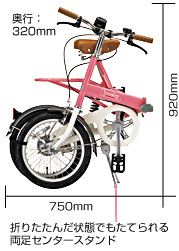
'Sneaker' Folding bike by Bridgestone (with 3 speed internal gearing) .
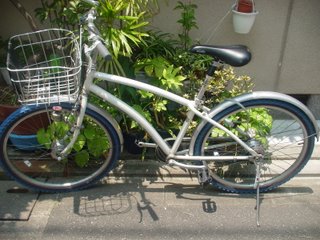
Basket on the front , bell from a dynamo , internal hub dynamo lights , 7-speed internal hub with grip shift , mud-guard, chain-guard, kick-stand, mountain bike tyres. ( you can click on these pictures to enlarge them ).
There seems to be a cultural reluctance among the bicycle retail industry in New Zealand to provide consumers with the choice to even experiment with the kinds of bicycles that would take cycling from being just something kids or young athletic types do, to becoming an intrinsic part of our everyday urban commuter transport infrastructure.
If people working in the cycle retail industry here are aware of the developments that are happening with commuter cycling in other countries, it isn’t being reflected in what they are presenting to the market.
Leaving it to ‘the market’ to arrive at the optimum outcome is obviously not working in the interests of promoting utility cycling in New Zealand.
A large percentage of the people who could, would and should be cycling now are probably not cycling for the simple reason that they can’t imagine being comfortable in the stooped low-down posture that must be adopted when riding mountain or road-racing bikes.
Most 'would-be' utility cyclists are probably put off by the fear that they'd have to ride as fast as they can go to have the right to a place in on-road cycle lanes.
Retailers are only catering for what they perceive is left of their market: recreational and ‘leisure’ cyclists.
There are scarce few alternatives provided for those who want a more pragmatic and comfortable cycling experience.
The cycle retail industry in New Zealand is excluding the sector which makes up the largest part ( 57% ! ) of the bicycle market in Japan.
An education campaign would be useful in helping the potential cycling public to become aware of the range of choices that exist to create the demand and facilitate the change from carbon burners to bicycles.
The Christchurch City Council could have a facilitative role in promoting a much wider range of bicycles to appeal to the wider public by hosting a Commuter Cycling Trade Fair to which foreign bicycle manufacturers could be invited from countries such as Japan, the Netherlands, Denmark, Germany and China to make contact with local retailers.
Funding could potentially come from participating commercial interests.
Even more amazing than how good ideas spread quickly is how they don't.
Urban utility bicycles from Sweden:
Koga Bicycles from the Netherlands
Gazelle Bicycles from the Netherlands
Pashley Bicycles from England
Nihola from Denmark
Urban utility cycling will never take off in New Zealand until cycle retailers in New Zealand start making bikes like these available to enable a much wider range of people to make the change.
A permanent or mobile display of various types of commuter cycles could be maintained by Local Governments to remind people of the alternative technologies that may help them to make the switch from driving to cycling.
---------------------------------------------------------------------------------------------------------
Some examples of alternative technologies not (commonly) available in New Zealand but which may be more appropriate for utility cycling in urban areas:
Traditional upright posture.
----------------------------------------------------------------------------
Internal hub gearing systems:
Internal 3,4,7 or 8 speed gearing systems manufactured by companies such as Shimano are popular in Japan as opposed to the dérailleur systems which are the only choice being offered by 99.9% of cycle retailers in New Zealand.
Low maintenance Internal hub gearing systems are more appropriate for riding in urban environments especially because gears can be changed very quickly to respond to the stop/go situations that cyclists often find themselves in on city streets.
Gears can also be changed while stationary whereas the dérailleur system used on mountain bikes necessitates that riders change gear while moving before entering a situation, -which can be a bit tricky when riding in the midst of motor - vehicles.
Losing your chain when trying to get out of the way of a car could be fatal.
--------------------------------------------------------------------------------------------------------------
Check out some of these web-sites for a look at some examples.
http://www.koga.com/uk/segment.asp?collection=7&segment=56
http://sheldonbrown.com/internal-gears.html
An excellent web-log on Internal Hub versus derailleur gearing systems in Portland, Oregon .
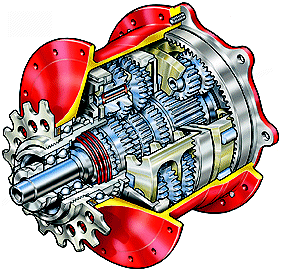
--------------------------------------------------
Internal hub powered lighting systems:


Internal hub dynamos are very commonly fitted into the front wheel on bicycles in Japan to provide power for lights.
They are silent, have no drag and are a world away from the noisy old 'burn your-front tyre and sap your energy' dynamos used in the old days.
Using an internal hub dynamo eliminates the need to use wasteful disposable battery powered lights which often run out in the middle of journeys.
Internal hub dynamo systems with LED and halogen lighting.
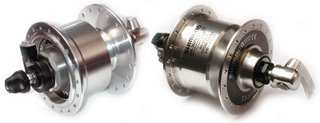
Why aren't these fantastic lighting systems being made available by cycle retailers in New Zealand ?
- Because ‘the market’ doesn't want them? Yeah, -right!
Carrying devices: Baskets attached to the front and back of bicycles are a major pragmatic advantage for commuter cyclists by enabling the carriage of shopping, books etc.
Mudguards and chain-guards: Quaint technologies from a bygone era but essential for riding in bad weather or in work clothes.
----------------------------------------------------------------

eXe folding bike with 20 inch wheels and 3 speed internal hub gears.
Folding bicycles:
These have become well established in Japan and are very useful for those who want to maximise their freedom in central urban areas after having reached them by either car (as part of a car-pooling cooperative) or on public transport such as bus or train.
http://www.bromptonbicycle.co.uk/
http://store.nycewheels.com/folding-bike.html
--------------------------------------------------------------------------------------------
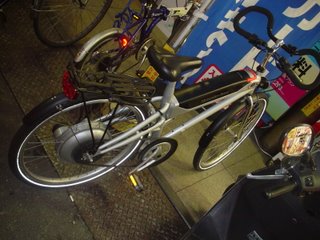
A Mercedes Benz Electric Bicycle Electric Power Assisted Bicycle: e.g.
Panasonic Bicycles
The Bakfiets Cargobike
Living with the Dutch kid and cargo hauling workhorse in Portland, OREGON U.S.A
- So it is with cycling in New Zealand,-with bicycles designed for off-road recreational riding being presented as the only option for use on flat city roads while the market is deprived of the alternatives which will inevitably prove to be more appropriate for urban environments .
There is a disappointingly restrictive lack of variety in the choice of appropriate cycling technologies being offered by all but a small handful of brave cycle retailers in New Zealand.
i.e. mountain bikes prevail in Christchurch city which is (for the most part) dead flat.

This graph is from Japan's biggest bicycle manufacturer 'Bridgestone' which has 11% of the market in Japan.
I'd guess that a similar graph for bicycle sales in New Zealand would look more like:
sports cycles 80% , kids, 19.99 %,
'comfort cycles' 0% , folding & compact and electric bicycles 0.01 %
Some examples of bikes that may prove to be more appropriate for use by urban 'utility' cyclists.

'Kyoto' by Fuji Bikes.
( ironically now manufactured in the U.S.A. and not available in Kyoto ,-although similar bikes are.
I personally used a similar bike in Kyoto for 4 years with 7-speed internal hub gearing , grip shift , internal hub dynamo for halogen lights with baskets on both front and back, complete with bells and umbrella holder.
I would never go back to a mountain bike.


'Sneaker' Folding bike by Bridgestone (with 3 speed internal gearing) .

Basket on the front , bell from a dynamo , internal hub dynamo lights , 7-speed internal hub with grip shift , mud-guard, chain-guard, kick-stand, mountain bike tyres. ( you can click on these pictures to enlarge them ).
There seems to be a cultural reluctance among the bicycle retail industry in New Zealand to provide consumers with the choice to even experiment with the kinds of bicycles that would take cycling from being just something kids or young athletic types do, to becoming an intrinsic part of our everyday urban commuter transport infrastructure.
If people working in the cycle retail industry here are aware of the developments that are happening with commuter cycling in other countries, it isn’t being reflected in what they are presenting to the market.
Leaving it to ‘the market’ to arrive at the optimum outcome is obviously not working in the interests of promoting utility cycling in New Zealand.
A large percentage of the people who could, would and should be cycling now are probably not cycling for the simple reason that they can’t imagine being comfortable in the stooped low-down posture that must be adopted when riding mountain or road-racing bikes.
Most 'would-be' utility cyclists are probably put off by the fear that they'd have to ride as fast as they can go to have the right to a place in on-road cycle lanes.
Retailers are only catering for what they perceive is left of their market: recreational and ‘leisure’ cyclists.
There are scarce few alternatives provided for those who want a more pragmatic and comfortable cycling experience.
The cycle retail industry in New Zealand is excluding the sector which makes up the largest part ( 57% ! ) of the bicycle market in Japan.
An education campaign would be useful in helping the potential cycling public to become aware of the range of choices that exist to create the demand and facilitate the change from carbon burners to bicycles.
The Christchurch City Council could have a facilitative role in promoting a much wider range of bicycles to appeal to the wider public by hosting a Commuter Cycling Trade Fair to which foreign bicycle manufacturers could be invited from countries such as Japan, the Netherlands, Denmark, Germany and China to make contact with local retailers.
Funding could potentially come from participating commercial interests.
Even more amazing than how good ideas spread quickly is how they don't.
Urban utility bicycles from Sweden:
Koga Bicycles from the Netherlands
Gazelle Bicycles from the Netherlands
Pashley Bicycles from England
Nihola from Denmark
Urban utility cycling will never take off in New Zealand until cycle retailers in New Zealand start making bikes like these available to enable a much wider range of people to make the change.
A permanent or mobile display of various types of commuter cycles could be maintained by Local Governments to remind people of the alternative technologies that may help them to make the switch from driving to cycling.
---------------------------------------------------------------------------------------------------------
Some examples of alternative technologies not (commonly) available in New Zealand but which may be more appropriate for utility cycling in urban areas:
Traditional upright posture.
----------------------------------------------------------------------------
Internal hub gearing systems:
Internal 3,4,7 or 8 speed gearing systems manufactured by companies such as Shimano are popular in Japan as opposed to the dérailleur systems which are the only choice being offered by 99.9% of cycle retailers in New Zealand.
Low maintenance Internal hub gearing systems are more appropriate for riding in urban environments especially because gears can be changed very quickly to respond to the stop/go situations that cyclists often find themselves in on city streets.
Gears can also be changed while stationary whereas the dérailleur system used on mountain bikes necessitates that riders change gear while moving before entering a situation, -which can be a bit tricky when riding in the midst of motor - vehicles.
Losing your chain when trying to get out of the way of a car could be fatal.
--------------------------------------------------------------------------------------------------------------
Check out some of these web-sites for a look at some examples.
http://www.koga.com/uk/segment.asp?collection=7&segment=56
http://sheldonbrown.com/internal-gears.html
An excellent web-log on Internal Hub versus derailleur gearing systems in Portland, Oregon .

--------------------------------------------------
Internal hub powered lighting systems:


Internal hub dynamos are very commonly fitted into the front wheel on bicycles in Japan to provide power for lights.
They are silent, have no drag and are a world away from the noisy old 'burn your-front tyre and sap your energy' dynamos used in the old days.
Using an internal hub dynamo eliminates the need to use wasteful disposable battery powered lights which often run out in the middle of journeys.
Internal hub dynamo systems with LED and halogen lighting.

Why aren't these fantastic lighting systems being made available by cycle retailers in New Zealand ?
- Because ‘the market’ doesn't want them? Yeah, -right!
Carrying devices: Baskets attached to the front and back of bicycles are a major pragmatic advantage for commuter cyclists by enabling the carriage of shopping, books etc.
Mudguards and chain-guards: Quaint technologies from a bygone era but essential for riding in bad weather or in work clothes.
----------------------------------------------------------------

eXe folding bike with 20 inch wheels and 3 speed internal hub gears.
Folding bicycles:
These have become well established in Japan and are very useful for those who want to maximise their freedom in central urban areas after having reached them by either car (as part of a car-pooling cooperative) or on public transport such as bus or train.
http://www.bromptonbicycle.co.uk/
http://store.nycewheels.com/folding-bike.html
--------------------------------------------------------------------------------------------

A Mercedes Benz Electric Bicycle Electric Power Assisted Bicycle: e.g.
Panasonic Bicycles
The Bakfiets Cargobike
Living with the Dutch kid and cargo hauling workhorse in Portland, OREGON U.S.A
Labels: Appropriate bicycles
Ideas for a billboard campaign
To promote utility cycling a series of billboards could be ( temporarily ) erected ( every spring ) at major entry points to Christchurch ( or any of New Zealand's cities).
Funding could be sought from Central Government, Local Territorial Authority and cycle retail groups or levied from motorists coming into the city.
1st billboard divided into 3 photographic images :
Photo taken from the perspective of a commuter from back of a crowded bus sitting in traffic.
Photo looking from the back of cars looking down along rows of cars stuck at traffic lights with a cyclist down at the front.
( Text ) Comfort? Speed ?
3rd picture of a cyclist : (Text) Freedom !
-to be placed where people who are stuck in traffic will have time to look at it .
Next billboard placed further along the same route near the next set of traffic lights.
'HOW?'
Large map of the area along which the traffic is moving back which extends back into the areas from which it is likely to have originated and continues on to the various destinations to which it may be going.
Coloured routes from A to B with distances and times that could give would-be cyclists some idea of the actualities of making the change to cycling.
3rd billboard.
'WHAT?' : Technologies: Presentation of generic standard ( mountain and 'road' bikes ) and 'alternative' technologies:
European style commuter bikes with internal hub gearing, internal hub dynamo lighting, baskets ,
Folding bikes,,
Electric 'power assisted' bicycles.
'WHY ?' : Benefits of cycling :health , freedom, convenience, traffic reduction, noise reduction, easy parking,
Kyoto protocol.
------------------------------------------------------------------
http://en.wikipedia.org/wiki/Utility_cycling
http://www.runmuki.com/commute/index.html
------------------------------------------------------------------
Raining ? too cold ? headwinds ? tired ? uphill ?
BUS + BIKE ?
Being able to put our bikes on buses ( and trains) would encourage more to take up cycling.
Have a look at this from Seattle:
http://transit.metrokc.gov/tops/bike/bikeride.html
From Santa Cruz
http://www.scmtd.com/changes/bikerack.html
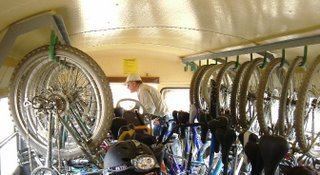
Funding could be sought from Central Government, Local Territorial Authority and cycle retail groups or levied from motorists coming into the city.
1st billboard divided into 3 photographic images :
Photo taken from the perspective of a commuter from back of a crowded bus sitting in traffic.
Photo looking from the back of cars looking down along rows of cars stuck at traffic lights with a cyclist down at the front.
( Text ) Comfort? Speed ?
3rd picture of a cyclist : (Text) Freedom !
-to be placed where people who are stuck in traffic will have time to look at it .
Next billboard placed further along the same route near the next set of traffic lights.
'HOW?'
Large map of the area along which the traffic is moving back which extends back into the areas from which it is likely to have originated and continues on to the various destinations to which it may be going.
Coloured routes from A to B with distances and times that could give would-be cyclists some idea of the actualities of making the change to cycling.
3rd billboard.
'WHAT?' : Technologies: Presentation of generic standard ( mountain and 'road' bikes ) and 'alternative' technologies:
European style commuter bikes with internal hub gearing, internal hub dynamo lighting, baskets ,
Folding bikes,,
Electric 'power assisted' bicycles.
'WHY ?' : Benefits of cycling :health , freedom, convenience, traffic reduction, noise reduction, easy parking,
Kyoto protocol.
------------------------------------------------------------------
http://en.wikipedia.org/wiki/Utility_cycling
http://www.runmuki.com/commute/index.html
------------------------------------------------------------------
Raining ? too cold ? headwinds ? tired ? uphill ?
BUS + BIKE ?
Being able to put our bikes on buses ( and trains) would encourage more to take up cycling.
Have a look at this from Seattle:
http://transit.metrokc.gov/tops/bike/bikeride.html
From Santa Cruz
http://www.scmtd.com/changes/bikerack.html

Fossil Fuels consumption in New Zealand

*In 2005 the transport sector in New Zealand used about 210 petajoules with (approximately) 159,000 barrels of oil per petajoule, which comes to ( approximately ) 33,390,000 barrels at US$72 per barrel ( at today's prices) costing us US$2,404,080,000 or NZ$ 3,787,977,319 divided by 365 to give us the total of NZ$10,378,020 per day for our transport related use of oil.
-Of course this figure is subject to fluctuations in the exchange rate, the price of oil etc but it does give us an easy to remember ballpark figure to refer to when quantifying the financial cost of our addiction to fossil fuels. It must be our biggest reducible expense.

http://www.nzherald.co.nz/location/story.cfm?l_id=146&ObjectID=10356363
http://www.med.govt.nz/templates/MultipageDocumentTOC____20515.aspx
Friday, August 18, 2006
Utility Cyclism
From "Moore, Garry (Mayor)"
Thanks for your HUGE e-mail Alan. It is stimulating and important.
Gazza
Garry Moore
Mayor
Christchurch City Council (6th of June , 2006 )
Who links to me?
Thanks for your HUGE e-mail Alan. It is stimulating and important.
Gazza
Garry Moore
Mayor
Christchurch City Council (6th of June , 2006 )
Who links to me?

